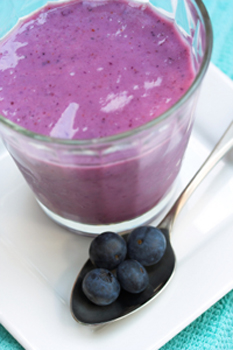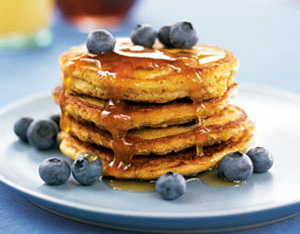 By Delia Quigley for Care2.com
By Delia Quigley for Care2.com
July is National Blueberry Month, a fitting tribute given that’s when these wholesome, juicy little berries come in to the peak of their season. Learn more about the nutritional and health benefits from this tiny blue food, and find several healthy blueberry recipes.
1. Blueberries’ Antioxidant Force
The first thing to point out is that, although blueberries are loaded with taste and antioxidants, they are also low in calories and high in fiber. This makes them the perfect food for dieters and anyone looking for a nutritious snack. One cup of blueberries provides you with the equivalent antioxidant content of five servings of carrots, broccoli, squash, and apples. What this means for your health is a lower risk of heart disease, vibrant, firm skin, and a boost in brain power.
The primary force behind blueberries’ super power is the phytonutrient anthocyanin, a particular type of flavonoid—the one that gives blueberries that deep blue pigment. These antioxidant benefits of anthocyanin are thought to protect your body against the damaging effects of free radicals and the chronic diseases associated with the aging process. Based on data from the USDA Human Nutrition Research Center on Aging, blueberries are among the fruits with the highest antioxidant activity. Using a test called ORAC (Oxygen Radical Absorbance Capacity), researchers have shown that a serving of fresh blueberries provides more antioxidant activity than many other fresh fruits and vegetables.
2. Blueberries’ Nutrient Content
Blueberries are also a good source of vitamins, minerals, dietary fiber, and are very low in fat and sodium. In just half a cup of blueberries you get 2 grams of fiber, equal to a slice of whole grain bread. Nutrient content of blueberries is a dieter’s dream come true. According to Health Magazine, blueberries are a particularly rich source of anthocyanins (also contained in apples, grapes, blackberries, radishes, and red cabbage).
Several studies suggest anthocyanins help prevent heart attack by discouraging blood clots from forming. They also appear to improve night vision and to slow macular degeneration by strengthening tiny blood vessels in the back of the eye. Based on the guidelines for getting your five or more servings a day of fruits and vegetables, one serving of fresh blueberries would be ½ a cup, one serving of 100 percent blueberry juice is ¾ cup, and one serving of dried blueberries is ¼ cup.
3. Healing Properties of Blueberries
What you get from eating blueberries are the many health-promoting benefits, which can include:
- Strengthening blood vessels
- Clearing arteries
- Improved vision
- More antioxidants for disease protection
- Enhanced memory
- Help for urinary tract infections
- Reversal of age-related physical and mental deterioration
- Promotes weight control
In a Newsweek article from June 17, 2002, neuroscientist James Joseph, of Tufts University, made it clear that when it comes to brain protection, there’s nothing quite like blueberries, which he calls the “brain berry.” Dr. Joseph attributes the blueberry’s health benefits to its antioxidant and anti-inflammatory compounds, and sees its potential for reversing short-term memory loss and forestalling many other effects of aging.
4. Modern Blueberry Production
Today, the most common variety of blueberry sold in the supermarkets are the “highbush” or “cultivated” blueberries, which grow on tree-sized shrubs that can get as high as fifteen feet tall. The “lowbush,” or wild blueberries, grow on small, ankle-high shrubs (only about one foot tall) and are about one-third the size of the cultivated blueberries. The wild blueberries are preferred by people who like the tangy, complex flavor of sweet and sour. The wild blueberries are from a different species than cultivated blueberries, but are part of the same plant family. Known as the “Caviar of Maine,” wild blueberries grow all over the state and some think they are tastier than the domesticated variety.
Blueberries can be used in recipes or just eaten plain. They are wonderful in baked goods, jams, pies, pancakes, salads, or, best of all, with a simple dollop of plain sheep’s yogurt. Fresh or frozen berries can be used in baked goods, but frozen berries will discolor the batter. To prevent this blue “bleeding,” roll the blueberries lightly in flour before adding them to the batter. It will help to know a few tried-and-true tips about cooking with fresh or frozen blueberries:
- When making blueberry muffins, the blueberries should be the final ingredient you add, just before you pour the batter into the muffin pans.
- Avoid over mixing blueberries in batter, as it may break the fragile berries and release their color.
- Fresh, frozen, or dried blueberries can be used in muffins, cakes, pancakes, and waffles.
- Use only fresh blueberries for topping cold cereals, baking fruit pies, and making fruit salads.
- Tossing blueberries in flour before adding them to cake batter keeps them from sinking to the bottom of the pan.
- When using frozen blueberries, increase baking time by 10 minutes for cakes and as much as 15-20 minutes for pies.
- Eat them all year long by keeping a supply of frozen berries in your freezer.
- Use blueberries to make a quick sauce for desserts and ice cream by heating frozen blueberries in a saucepan with a little juice or water and thicken with arrowroot powder.
- No matter what your culinary experience, you will find blueberries are easy and virtually foolproof to use in recipes.
Excerpted from, The Everything Superfoods book by Delia Quigley.
Try these Blueberry Recipes:

